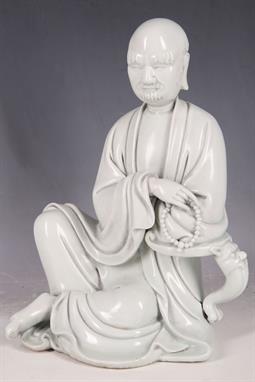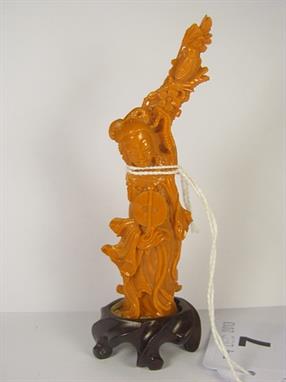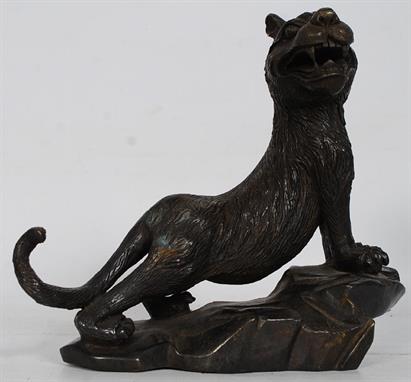We found 708 price guide item(s) matching your search
There are 708 lots that match your search criteria. Subscribe now to get instant access to the full price guide service.
Click here to subscribe- List
- Grid
-
708 item(s)/page
Chinese Style Serpentine Kwan Yin Statue . An undated archaistic carved statuette of Kwan Yin standing with the right hand in the gesture of discussion, the left arm cradling a sceptre, nimbus to the rear of the head. 2.3 kg, 34.5 cm (13 3/4"). From a central London collection formed between 1990-2000. TimeLine Auctions Ltd arranges printed catalogue rostrum Auctions, eAuctions and Timed Auctions where we offer antiquities, ancient artefacts / artifacts, antiques, collectibles, coins, medals and books for public sale. Fine condition.
A figure of Amitabha China, 18th century Embossed copper and gold laminate This statue shows gilt remains and portrays the Chinese version of the Transcendent Buddha Amitabha. The figure rests on a richly decorated high base, which still shows traces of red lacquer on the reverse. The Buddha sits with his legs crossed in padmasana position. His hands rest on his lap in the dhyanamudra. lxhxp 20 cmPrezzo di partenza: ?2250
statue en bronze à patine brune de l`immortel Zhang Guo Lao lisant sur un mulet. Chine du sud ou Indochine statue en bronze à patine brune de l`immortel Zhang Guo Lao lisant sur un mulet Chine du sud ou Indochine. H. 44 cm Chinese Art - Asian Art - Bronze Asian art - Chinese - Japanese - Korean.-Corean - Oriental arts asiatiques Asiatika
CARVED LOHAN STATUE. China, 19th century or earlier, carved wood. Worn polychrome paint. 57"h. Ex Chinese Art Gallery (New York). Descriptions provided in both printed and on-line catalogue formats do not include condition reports. The absence of a condition statement does not imply that the lot is in perfect condition or completely free from wear and tear, imperfections or the effects of aging. Interested bidders are strongly encouraged to request a condition report on any lots upon which they intend to bid, prior to placing a bid. All transactions are governed by our Conditions of Sale.
China, Japan, Colombia and Costa Rica. A mint 1980 to 1982 Chinese collection and a mint 1978 to 1981 Japanese collection. Noted China 1980 Paintings of Qi Baishi M/S, Return of High Monk Jian Zhen's Statue, Kites, Guilin Landscapes, 1980 Liu Yuan, 1981 Palace Lanterns, The Twelve Beauties of Jinling set and M/S, 1982 Medical Plants M/s.
Chinese-American Bank of Commerce, 1920 Issue Specimen.China, 1920. $1. P-S230s3. (S/M #C271-1). Specimen banknote. Black on m/c underprint with Statue of liberty vignette on right, shield on left flanking m/c medallion in middle, back green, Red specimen overprint, “00000” serial numbers and POC`s. PMG graded Gem Uncirculated 66 EPQ (Exceptional paper Quality). The highest graded out of two by PMG and this example may very well be the finest known. ABNC.
Chinese American Bank of Commerce, 1920 Second Issue Specimen Banknote.$5, P-S236s4, Specimen banknote, Statue of Liberty in middle on brown and m/c face, Red specimen overprint, “00000” serial numbers and POC`s. PMG graded Choice About Uncirculated 58 NET with note of corner cut on the upper left and the note is also cut close on the bottom margin. Rare note in any condition. ABNC.
Chinese Tibetan Style Bronze BuddhaAn undated archaistic cast bronze statue of the Buddha, seated on a crouching lion with raised tail; the lion with face upturned towards the Buddha whose right hand rests on his knee; the base rectangular with leaf detailing; hollow to the underside. 2.5 grams, 24 cm (9 1/2"). Property of a London Gentleman; acquired before 1990. Fine condition.Starting Price: 150
Chinese Style Gilt-Bronze Buddha StatueAn undated archaistic gilt-bronze statue of the Buddha seated on a waisted plinth, the hands raised to the chest in the mudra gesture of instruction. 935 grams, 14 cm (5 1/2"). Acquired on the London art market in the 1960s. Fine condition.Starting Price: 500
Chinese Emperor T`ai-tsu 1 Guan BanknoteMing dynasty, 1368-1398 AD The oldest paper money in existence. A large mulberry bark paper banknote of the Ming emperor T`ai-tsu, believed issued 1375 AD, with face value of one guan (1,000 cash) with woodblock impressions each side, the front declaring it to be a `Great Ming Treasure Certificate` in Chinese characters and stating that a reward will be paid to anyone who denounces a counterfeit; with the added warning that The counterfeiter shall be decapitated. The informant will receive 250 taels of silver, and in addition the entire property of the criminal; the note bearing additional official seals in red. 5 grams, 34 x 22 cm. (13 x 8 3/4"). Ex Rosemary Yea collection. Two caches of these early banknotes have been reported, the first in 1900 during the Boxer rebellion when Peking was occupied, a statue was overturned by European soldiers and a quantity of notes, with other items, found in the base; the second found in 1936 when a `bale` of the notes was discovered during building works in Peking.Very fine condition. Rare.Starting Price: £900
A rare Chinese hardwood fan stand, from a throne room set, 18th century, in zitan and other hard woods, well carved as a recumbent caparisoned elephant, with his head turned to dexter and with a small vase upon his back, the base carved in relief with stylized mythical beasts and bands of ruyi heads, damage to the vase, 57cm. (2) Provenance: a private German collection. Cf. L Yang and E Capon, Translucent World, Chinese Jade from the Forbidden City, no.106 for a pair of red lacquer examples with decorative fans flanking an imperial throne. During the Qing dynasty elephants carrying vases on their backs appeared in processions to celebrate the emperor Qianlong`s birthday. Throne room sets usually consist of a throne in the centre, a screen at the back; and on either side of the throne, an elephant statue with a vase on its back (symbolizing universal peace), a standing fan, a luduan unicorn statue, and a censer. This assemblage is commonly referred to as the "throne-room group". See also: China, The Three Emperors 1662-1795, p.391, where throne furniture and settings are discussed in more detail.
The Son of Heaven`s Jade Elephants. An Exceptional and Highly Important pair of Chinese Imperial Jade Elephants from a Throne-room group of the Emperor Qianlong. Each with a Qianlong four character reign mark and of the period 1736ð95, each 19cm long, 17cm high (total weight 12kg approx.) Each beast stands four square and with its head turned slightly to the side, the ears incised with veining, the eyes crisply incised above trunks which extend about their feet. The grey-green stone flecked with golden-brown striations. Provenance The Hon. Mrs Mary Anna Marten OBE, Crichel House, Dorset. Catalogue Note; An almost identical pair of Qianlong jade elephants from the Forbidden City, but with cloisonne saddle fittings and carrying vases, were exhibited at the Art Gallery of New South Wales, Sydney Australia in 2007 and are illustrated by Liu Yang in the exhibition catalogue Translucent World, no.109. These examples are also illustrated by Ho & Bronson, cf. Splendors of China`s Forbidden City, the Glorious Reign of the Emperor Qianlong, p.51, where Hu Desheng, describing Qianlong`s thrones, states: `The set usually consists of a throne in the centre, a screen at the back; and on either side of the throne, an elephant statue with a vase on its back (symbolizing peace), a standing fan, a luduan unicorn statue, and a vertical censer. This assemblage is commonly referred to as the `throne-room group.` See also: China, The Three Emperors 1662ð1795, p.391, where throne furniture and settings are also discussed. In China, the elephant is a symbol of strength, astuteness and happiness. They existed in China during the bronze age, but like the rhinoceros, soon were hunted to extinction. In the Ming dynasty, there were stables in the Forbidden City for the elephants that were given as gifts to the Ming emperors from the rulers of Burma. During the Qing Dynasty elephants carrying vases on their backs appeared in processions to celebrate the Emperor Qianlong`s birthday, and so these massive quadrupeds continued to be a popular subject for portrayal in the decorative arts. The Qing rulers commissioned jade elephants in formal standing poses, which were paired and placed flanking the Imperial thrones. For other examples of jade elephants, cf. Chinese Jade, Spink & Son Ltd., London, 1998, no. 23 for a spinach-green jade elephant, from the Estate of Empress Friedrich, Schloss Friedrichshof, and Alex Kerr, Immortal Images. The Jade Collection of Margaret and Trammell Crow, Dallas, 1989, p. 41. For another elephant from The Concordia House Collection, cf. Sotheby`s New York, 19th March 2007 lot 9, and Stanley Nott illustrates a grey elephant dated to the Qianlong period in the collection of Oscar Raphael Esq. pl. LXX. Stanley Charles Nott, in his Chinese Jade Throughout the Ages, records: `an exceptional pair of such carvings in the private collection of Her Majesty Queen Mary` and comments: `These specimens are obviously the work of the Imperial workshops of the Ch`ien Lung period`. Cf. The International Exhibition of Chinese Art, The Royal Academy of Arts, London 1935/6 catalogue no. 2328, where these elephants were illustrated.
A Chinese Scroll Painting, late 20/early 21st century, depicting a view of the Great Wall of China, black and coloured ink on paper, with inscription and one seal, 80x150cm: together with one other scroll painting by the same hand, depicting figures by a statue, with inscription and one seal, (2) (scroll)
A Chinese export octagonal commemorative plate for Mavia Iuliana with central roundel of statue within a gilt border of louvel and key pattern (cracked) 24.5cm diameter, another with interlaced initials and cherubs within a border of peonies and diaper (repaired) and a Royal Copenhagen botanical plate (3)
A Paris Sevres porcelain coffee can, depicting classical maidens adorning a statue of Bacchus in an oval panel, the mauve ground with raised gilt dots in rows, a gilt border and scroll handle, unmarked. Together with a late 18th century Chinese porcelain sparrow beak jug, decorated puce foliage and insects in European style (rim chipped) and a continental porcelain saucer with Meissen marks, possibly St. Cloud. (3).
-
708 item(s)/page














































